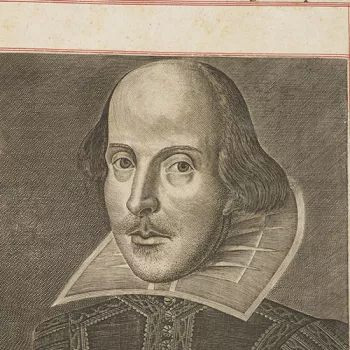A Modern-Day Miniature Library
Discover books created in celebration of 100 years of Queen Mary’s Dolls’ House.

Reading time: 3 minutes
In celebration of the centenary of Queen Mary’s Dolls’ House, a selection of modern-day writers and binders have contributed handwritten and hand-bound books to a new, doll-sized collection, in an initiative championed by Her Majesty The Queen.
After being exhibited in a special display at Windsor Castle during 2024, the little books will be kept together in the Royal Library. The new books include a miniature version of The Gruffalo by Julia Donaldson and Axel Scheffler and A Tiny Ghost Story by Anthony Horowitz. Her Majesty The Queen has contributed her own miniature book to the collection: a handwritten introduction to the Modern-Day Miniature Library project.
Queen Mary’s Dolls' House
The Dolls’ House was built between 1921 and 1924 as a gift from the nation to Queen Mary following the First World War. It was designed by the architect Sir Edwin Lutyens, working alongside Princess Marie Louise. They were joined by hundreds of artists, designers, manufacturers and craft experts in their quest to create a time-capsule of the 1920s. It is a perfect 1:12 scale replica of an Edwardian-style residence – complete with electricity, working lifts and running water.
The Dolls’ House Library
One of the most remarkable rooms of the Dolls’ House is its Library. Like the rest of the rooms in the House, its contents are real, but small. Of the nearly 600 books on its shelves, over 170 are manuscripts handwritten by the most notable authors of the 1920s.
Sir Arthur Conan Doyle, A.A. Milne, Thomas Hardy and Vita Sackville-West are among many of the literary figures who squeezed poems, stories, plays and essays into pages around only 4 cm high. Their books were bound in some of the most prominent binderies of the time.
Just like when the Dolls’ House Library was collected in the 1920s, today’s authors were free to copy out by hand work they had already published, or to write something new. The little booklets they wrote in were then bound by leading designer-binders. While in the 1920s a traditional style of binding was preferred for the Dolls’ House books, the artistic attitudes of today are reflected in the individual creativity and use of alternative materials seen on the bindings of the modern books.
The Royal Bindery
A selection of the new miniature books have been bound in the Royal Bindery at Windsor Castle. Established during the reign of George III, the Royal Bindery today not only conserves, protects and repairs the Royal Collection's books, albums and manuscripts, but also creates new bindings for State Gifts and other royal occasions.
The Royal Bindery’s work to deliver the new doll-sized library began with preparing the tiny blank booklets given to authors to write in, and culminated in making designer bindings in miniature.
A Modern-Day Miniature Library
The new collection of books contains a variety of different types of writing. Poetry, short stories and ghostly tales are all included, along with plays, articles and recipes. In the 1920s, children’s authors were not asked to contribute to the Dolls’ House Library, but the new collection for 2024 features several works written for children.
The new collection is also more illustrated than the library formed for the Dolls’ House in the 1920s, and the books contain pictures by leading book artists, the authors themselves, and talented amateurs, including children.
See a list of the newly created books below and find out more in our Collection Online.
|
Author |
Title |
Bound by |
Royal Collection Inventory Number (RCIN) |
|---|---|---|---|
|
Her Majesty The Queen |
Queen Mary’s Doll’s House: foreword | Glenn Bartley, Royal Bindery | 1171616 |
|
Simon Armitage |
Matthew Stockl, Royal Bindery |
1171600 |
|
|
Alan Bennett |
Andreas Maroulis, Royal Bindery |
1171604 |
|
|
Malorie Blackman Illustrated by Elizabeth Mira Morrison |
Bayntun-Riviere |
1171607 |
|
|
Lucy Caldwell Illustrated by Orla Routh |
|
Gillian Stewart, Juju Books |
1171611 |
|
Joseph Coelho, Children’s Laureate |
Matthew Stockl, Royal Bindery |
1171619 |
|
|
Imtiaz Dharker |
Flora Ginn |
1171606 |
|
|
Julia Donaldson and Axel Scheffler |
Glenn Bartley, Royal Bindery |
1171614 |
|
|
Bernardine Evaristo |
Sue Doggett |
1171613 |
|
|
Sebastian Faulks |
Shepherds, Sangorski & Sutcliffe |
1171612 |
|
|
Philippa Gregory |
Stuart Brockman, Brockman Bookbinders |
1171602 |
|
|
Robert Hardman Illustrated by Phoebe Hardman |
The Coronation of King Charles III and Queen Camilla, 6· V· 2023 |
Ted Bennett |
1171618 |
|
Anthony Horowitz |
Angela James |
1171601 |
|
|
Charlie Mackesy |
Hannah Brown |
1171608 |
|
|
Sir Ben Okri |
Rachel Ward-Sale, Bookbinders of Lewes. |
1171615 |
|
|
Tom Parker Bowles |
Andreas Maroulis, Royal Bindery |
1171620 |
|
|
Elif Shafak |
Haein Song |
1171617 |
|
|
Sir Tom Stoppard |
Lester Capon |
1171609 |
|
|
Sarah Waters |
Christopher Shaw |
1171610 |
|
|
A.N. Wilson |
Peter Jones |
1171605 |
|
|
Dame Jacqueline Wilson |
Eri Funazaki |
1171603 |










